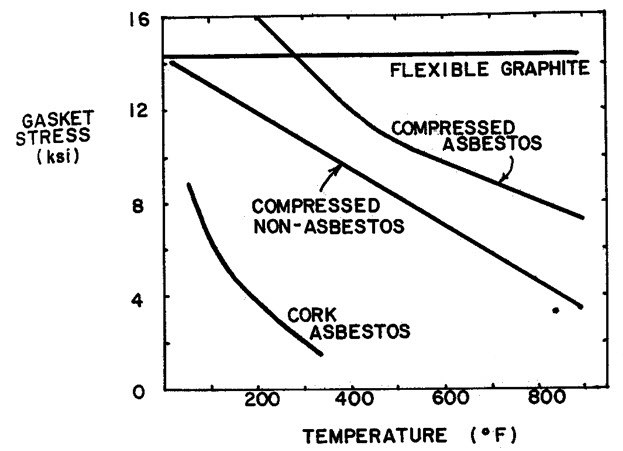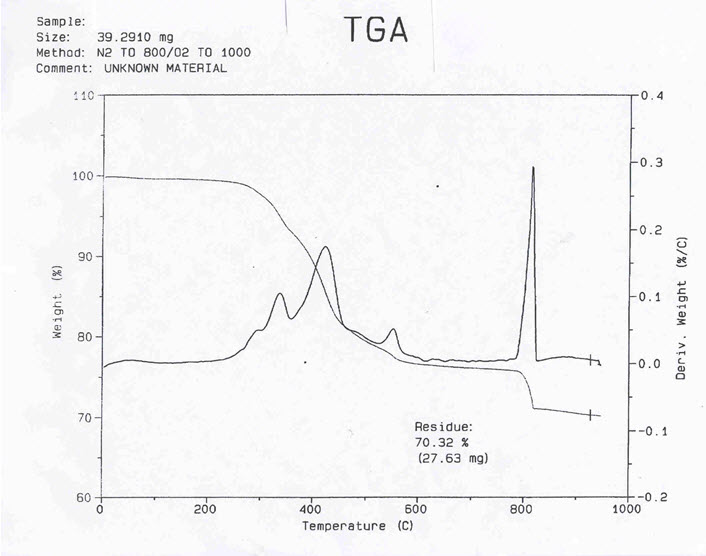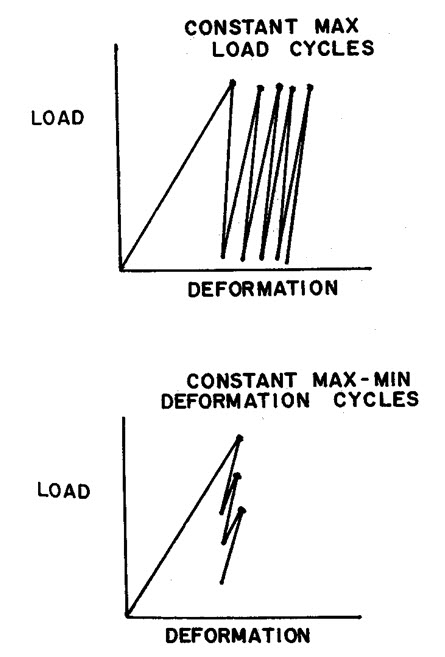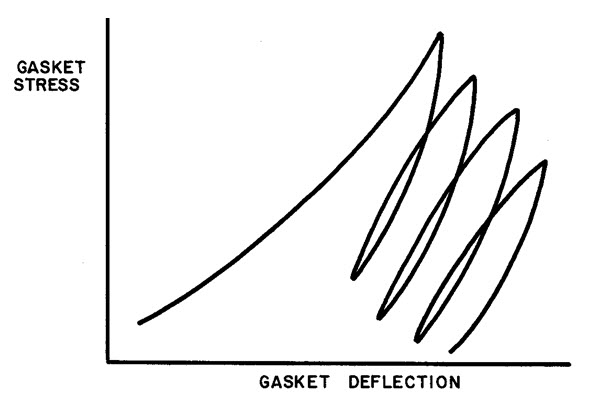Of all the environmental parameters affecting the behavior of gasketed joints is that of elevated temperature. Thermal cycles can also cause even more distress. Below are listed several of the effects:
Physical degradation of the gasket
High temperatures can degrade a gasket in several ways, changing such things as tensile strength, resilience, modulus of elasticity, and the ability to support compressive loads. Figure 1 below shows a general decrease in maximum service stress for a variety of materials.

Only flexible graphite in this example remains unaffected by the temperatures shown here. A solid metal or embossed metal gasket (not shown) would be similarly unaffected. Curves for the other materials represent the points at which the combination of stress and temperature plotted would create irreversible distortion and /or decomposition of the gasket.
Many of the proposed asbestos substitute composite materials fail by thermal degradation, the clays or other organics used as binders turn to powder when subjected to extremely high temperatures. A relatively simple method for determining the effect of elevated temperature on materials is through the use of a TGA (Thermo-Gravimetric analysis). In the example shown in the example of figure 2 indicates that the gaskets made from this material would degrade at temperature above 300°C.
NOTE: An article about the TGA can be found in the Winter 2005 issue of The Gasket Fabricator

Creep and Relaxation
Elevated temperature can increase the amount of creep or relaxation a gasket experiences under load. The reported room temperature relaxation under light loads of a compressed asbestos gasket is about 17%. Creeps and relaxations of the same material under similar loads have been reported as high as 60% at approximately 400°F. Results are similar for other materials especially those with organic binders and with any fillers which degrade at elevated temperature. An example of such a fuller would be cellulose.
Thermal Expansion or Contraction
One-shot differential thermal expansion or contraction can increase the load on a gasket. This phenomenon can raise or lower gasket stress. Sealability can be improved or degraded, depending on whether or not gasket stress is increased of decreased.
Thermal Cycles
More complex and difficult to predict changes can occur if repeated thermal cycles as involved. Two types of behavior are represented in figure 2 below.
The effect of the thermal cycling as a gasket is called ratcheting and can be seen in two forms, stress ratcheting and deflection ratcheting. This ratcheting is caused by a combination of factors, including time-dependent plasticity (creep), time-independent plasticity (hysteresis) and the general non-linearity in the stress-strain response of the gasket.
If the load (contact stress) is cycled between constant maximum and minimum valves, the deflection of the gasket is called “ratcheted” with the gasket becoming thinner with each cycle. The thickness with eventually stabilize. This condition is illustrated in the top curve.
If the gasket is cycled between maximum and minimum deflections, the stresses of the gasket progressively decreases, as shown in the second curve. If the gasket fails to stabilize at a residual load valve above that which is required to maintain the seal, the gasket will leak.
Most gaskets in field applications will experience a combination of stress ratcheting and deflection ratcheting as illustrated in figure 3.

The effect of the thermal cycling as a gasket is called ratcheting and can be seen in two forms, stress ratcheting and deflection ratcheting. This ratcheting is caused by a combination of factors, including time-dependent plasticity (creep), time-independent plasticity (hysteresis) and the general non-linearity in the stress-strain response of the gasket.
If the load (contact stress) is cycled between constant maximum and minimum valves, the deflection of the gasket is called “ratcheted” with the gasket becoming thinner with each cycle. The thickness with eventually stabilize. This condition is illustrated in the top curve.
If the gasket is cycled between maximum and minimum deflections, the stresses of the gasket progressively decreases, as shown in the second curve. If the gasket fails to stabilize at a residual load valve above that which is required to maintain the seal, the gasket will leak.
Most gaskets in field applications will experience a combination of stress ratcheting and deflection ratcheting as illustrated in figure 3.

Larry,
Very interesting observations on dynamic creep-relaxation effects. Because pure creep & pure relaxation are rarely seen, except in contrived applications, the combined creep-relaxation behavior is of more practical interest. I’m of the opinion that the combined behavior could be termed “constant stiffness”. This is the basis for most bolted joint characteristics, but the associated stiffness value varies with all planar locations in the joint (compressive system + bending).
Thanks for your input.